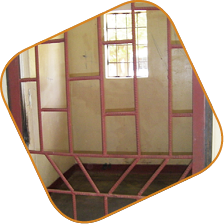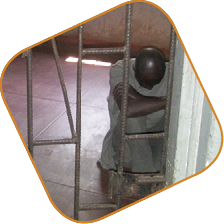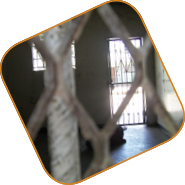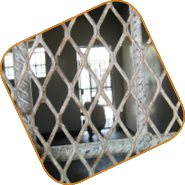7(F). Restraints and seclusion
You just have to behave.
There is no legal or regulatory framework for the use of restraints or seclusion. None of the psychiatric facilities monitors visited had a policy on their use.145 Restraints and seclusion are used on patients on detention orders and those who are classed as voluntary patients. Monitors observed widespread use of seclusion in rooms with appalling physical conditions.

 Photo: Shutterstock
Photo: Shutterstock
Staff-patient ratios were very low. Staff told monitors about the difficulty of handling a patient who they perceived to be aggressive. Patients at Chainama Hills Hospital’s acute wards said that some staff occasionally slapped or hit them. Staff said that they used restraint and seclusion to manage patients who “keep walking around and disturbing other patients” and at the request of relatives. Some patients at Chainama said that, “you just have to behave” to avoid restraint and seclusion. Without a complaints mechanism and anything being written down, patients had no opportunity to for allegations of ill-treatment investigated by an independent authority.
Restraints on the psychiatric units included chemical restraints with sedatives, manual restraints (staff holding down patients), and handcuffs in units without seclusion rooms, such as at Chipata. Staff at the Kabwe unit told monitors that when all seclusion rooms were occupied by patients, additional patients considered as requiring seclusion would instead be restrained by being tied with ropes or chains which family members used when transferring patients to the hospitals.146
Seclusion rooms were prevalent. Chainama Hills Hospital had at least five in each of the acute wards. At the new Livingstone wards there were no seclusion rooms and the small bedrooms allowed for a less threatening environment. Ndola Unit had two “closed” seclusion rooms (locked with a padlock) and one open seclusion room (used for observing newly-admitted patients on the male ward) and one closed seclusion room on the female ward. Kabwe Unit had one seclusion room used by both male and female wards located on the male ward. Chipata Psychiatric Unit, as well as the Chainama Hills Hospital male forensic ward, and wards E and F had no seclusion facilities. Instead of seclusion, ward staff reported using handcuffs and chemical restraints at Chipata and on the Forensic Ward, while patients from wards E and F at Chainama were sent to wards B and C respectively to be placed in seclusion.

 Photo: Two seclusion rooms in Ward C of the Chainama Hills Hospital. A man slept during the lunch period on an empty floor (left). A patient was given food by a fellow patient, sending the plate under the door after eating (right), 29 October 2012. © MDAC.
Photo: Two seclusion rooms in Ward C of the Chainama Hills Hospital. A man slept during the lunch period on an empty floor (left). A patient was given food by a fellow patient, sending the plate under the door after eating (right), 29 October 2012. © MDAC.
The sizes of seclusion rooms ranged from two to six square metres. There was no access to toilet facilities or a bucket. Patients were forced to defecate and urinate on the same floor space that they were required to sleep. While some patients said that they were naked in seclusion rooms, monitors observed others with clothes or uniforms in seclusion rooms. Monitors observed that patients in seclusion on the two acute wards of Chainama Hills Hospital were dependent on fellow patients to bring them food at meal times. Patients explained that they always rely on fellow patients to provide them with drinking water while in seclusion. Some patients reported avoiding drinking water when in seclusion to reduce the humiliation of urinating in such a small place where there was no drainage.
Monitors found no evidence that staff informed patients in seclusion why they were there, for how long they would be there, or about their rights. There was no mechanism by which the patient could appeal a seclusion decision. At the Ndola male ward, monitors observed a man handcuffed in a closed seclusion room. Staff said that he would be there for fourteen days because he was on detention order. Staff at Chainama Hills Hospital told monitors that they secluded people for up to 14 days, adding it is usually one day for patients not on detention orders.
A patient detained at Chainama Hills Hospital explained:
I woke up in the seclusion room without any of my clothes on me or in the room. Other patients gave me water. One day the staff gave me some porridge. I had to go to the toilet in the corner of the room to avoid being seen. If I talked they said I was showing off.
Another patient on the male acute ward at Chainama could not remember how long he had been in seclusion but pleaded with monitors to ask the nurses to remove him so that he could drink water and shower.
145 The Mental Health Disorders Act 1951 is silent on the subject, with powers to apply restraints and seclusion being instead inferred as part of detention.
146 Interviews with psychiatric clinical officers at the Kabwe psychiatric wards, Kabwe, Zambia: 24 October 2012 and 26 January 2014.

